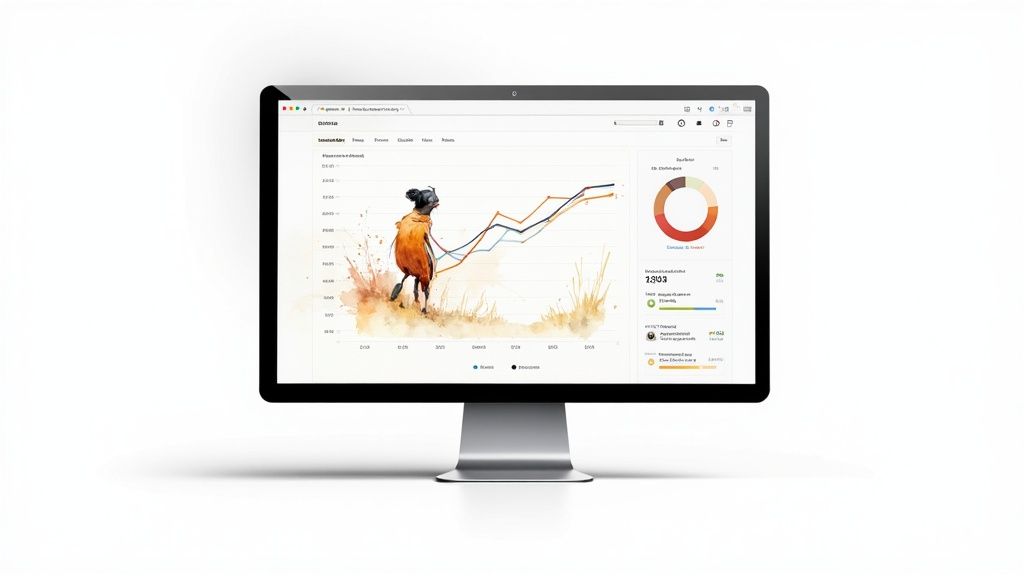




Twitter search trends provide crucial real-time insights into the ever-evolving online discourse. This data offers a valuable glimpse into developing narratives, shifts in public sentiment, and burgeoning topics, often before they reach mainstream media. Understanding these trends is essential for marketers, researchers, and anyone seeking to stay informed.
This necessitates distinguishing between trending topics and search trends. Trending topics, determined by Twitter's algorithm, showcase popular hashtags and subjects. Search trends, however, reveal what users actively seek on the platform, providing a different perspective on public interest.
Twitter's search trends derive power from the platform's massive data volume. Processing roughly half a billion tweets daily, Twitter generates a vast, dynamic dataset of public opinion. Advanced search features further amplify this data's value. Users can refine searches by date, keyword, and other criteria, unlocking granular insights. By using precise keywords and operators, users can track sentiment, identify emerging influencers, and gain a deeper understanding of specific topics. More on this topic can be found here.
Effective use of Twitter search trends hinges on understanding the algorithm that governs them. Several factors contribute to how Twitter identifies and ranks these trends. Velocity, the speed at which a search term gains popularity, is a key element. Volume, the total number of searches, also plays a significant role. A sudden spike in searches is more likely to propel a term to the trending list than consistent, stable search volume. Furthermore, the algorithm incorporates location data, allowing for both global and localized trend analysis.
Monitoring Twitter search trends offers several key advantages. For brands, it acts as an early warning system for potential crises. This real-time awareness enables proactive responses and effective online reputation management. This is especially crucial in volatile industries like cryptocurrency, where sentiment can shift rapidly, impacting market dynamics. Platforms like Coindive utilize this data to provide users with up-to-the-minute market insights.
Twitter search trends also offer valuable market research. By tracking conversations around products, competitors, and industry keywords, businesses can understand consumer preferences, identify unmet needs, and even discover new product opportunities. This real-time feedback loop promotes business agility and data-driven decision-making. Finally, understanding search trends empowers content creators to tailor their material to current interests, maximizing reach and engagement.

Sifting through the massive volume of tweets generated daily can be a daunting task. Targeted search operators offer a powerful solution, enabling users to uncover relevant Twitter search trends with precision. These specialized commands act as filters, cutting through the noise to pinpoint specific information.
For instance, Boolean operators such as "AND," "OR," and "NOT" drastically refine search results. This allows users to focus on specific keywords relevant to their industry, brand, or competitors, providing a more manageable and relevant stream of information.
Boolean search logic is essential for effective analysis of Twitter trends. Using "AND" between keywords narrows your search, returning only tweets containing both terms. This is particularly useful when researching very specific topics or combinations of keywords.
Conversely, using "OR" broadens the search to include tweets containing either term. This function is beneficial when exploring a wider range of related topics. The "NOT" operator excludes specific keywords, further refining results by filtering out irrelevant content.
Parentheses can be employed to group search terms and prioritize specific combinations. This provides granular control, allowing users to uncover nuanced conversations and identify emerging trends with greater accuracy.
Understanding the geographical context of conversations adds another layer of depth to Twitter trend analysis. The "near:" operator filters tweets based on location. Searching "cryptocurrency near:London," for example, reveals discussions taking place in the London area.
This location-based filtering provides valuable insights into regional trends. Businesses can gain a better understanding of competitor activity and gauge audience sentiment in specific areas.
Beyond Boolean and location-based operators, Twitter offers several other commands to refine searches. The "from:" operator limits results to tweets from a specific user, enabling monitoring of competitors or key influencers.
The "to:" operator displays tweets directed at a particular user, highlighting audience engagement and conversations. Analyzing these interactions can reveal valuable insights into public perception and brand reputation.
Finally, the "min_retweets:" and "min_faves:" operators surface highly engaging content by filtering based on retweets or likes. This helps identify influential content and understand what resonates with the target audience.
By combining these operators, users gain a competitive edge in understanding Twitter search trends. For instance, a search like "crypto AND blockchain min_retweets:100" reveals popular and impactful discussions about cryptocurrency and blockchain technologies.
To help illustrate the functionality of these powerful tools, the following table offers a detailed guide to utilizing Twitter search operators:
Introducing a comprehensive guide to essential Twitter search operators. This table provides a quick reference to help refine searches and unlock the full potential of Twitter data.
| Operator | Function | Example | Result |
|---|---|---|---|
AND |
Returns tweets containing both terms | marketing AND strategy |
Tweets containing both "marketing" and "strategy" |
OR |
Returns tweets containing either term | social OR media |
Tweets containing either "social" or "media" |
NOT |
Excludes tweets containing a specific term | advertising NOT facebook |
Tweets containing "advertising" but not "facebook" |
near: |
Returns tweets from a specific location | technology near:Berlin |
Tweets mentioning "technology" within a certain radius of Berlin |
from: |
Returns tweets from a specific user | from:elonmusk |
Tweets from Elon Musk |
to: |
Returns tweets directed at a specific user | to:tim_cook |
Tweets directed at Tim Cook |
min_retweets: |
Returns tweets with a minimum number of retweets | #AI min_retweets:50 |
Tweets using #AI with at least 50 retweets |
min_faves: |
Returns tweets with a minimum number of likes | digitalart min_faves:100 |
Tweets mentioning "digitalart" with at least 100 likes |
This table showcases how strategically using search operators can significantly enhance the precision and relevance of Twitter searches. Mastering these operators empowers users to extract valuable insights from the vast Twitter landscape.

Leading brands recognize the significant value of Twitter search trends. They go beyond passive observation, actively integrating these trends into marketing campaigns to resonate with their target audience. This involves meticulous monitoring of relevant conversations to identify content opportunities, optimize messaging timing, and create engaging content.
Consider a company launching a new fitness tracker. By monitoring Twitter search trends related to fitness, health, and wearable technology, they gain valuable insights into consumer discussions. This includes identifying desired features, understanding concerns about existing products, and uncovering emerging fitness trends.
Effective use of Twitter search trends requires a robust trend monitoring system. This involves establishing a framework to track both industry-wide shifts and competitor activities, offering a substantial competitive advantage. For B2C companies, this might entail monitoring consumer preferences and lifestyle changes. B2B organizations may focus on industry news, emerging technologies, and competitor announcements. You might be interested in: How to master credible crypto Twitter.
Furthermore, these systems should incorporate alerts for keyword search volume spikes. Real-time notifications enable swift responses to emerging opportunities or potential crises, allowing companies to adapt their messaging and maintain a proactive online presence. This agility positions brands at the forefront of relevant conversations, maximizing visibility and impact.
Beyond real-time monitoring, analyzing historical trends provides valuable insights for campaign planning. Examining past Twitter search trends reveals recurring patterns in audience behavior, often overlooked by those focused solely on current trends. This analysis goes beyond casual observation; it's a powerful tool for marketing and research. Tools like Tweet Binder and TrackMyHashtag offer comprehensive analytics and historical data access, enabling analysis of past campaigns and future strategy planning. These platforms provide detailed metrics like engagement rates, top influencers, and hashtag performance over time. Tweet Binder, for instance, allows users to download datasets of old tweets for in-depth analytical reports, crucial for understanding trend evolution. More detailed statistics can be found here. By identifying these patterns, businesses can anticipate future trends, proactively plan aligned campaigns, and understand evolving audience preferences. This enables marketers to optimize messaging, anticipate shifts in consumer behavior, and develop campaigns with long-term resonance.

Identifying relevant Twitter search trends is only half the battle. To truly capitalize on them, you need the right analytical tools. This means selecting platforms that deliver actionable insights, not just surface-level data. The options are diverse, ranging from Twitter's own analytics to specialized third-party platforms.
Twitter offers basic analytics that provide a solid starting point, particularly for those new to trend analysis. These native tools offer a general overview of your account's performance, including key metrics like impressions, engagement, and audience demographics. This data can inform your content strategy by highlighting topics that resonate with your followers. However, for more in-depth trend analysis beyond your own profile, specialized tools are essential.
Several third-party tools offer advanced features for tracking and analyzing Twitter search trends. These platforms often include advanced filtering, historical data access, and sophisticated visualization options. Some also incorporate sentiment analysis, revealing the emotional tone of conversations surrounding specific keywords or hashtags. This deeper understanding of public opinion is crucial for effective marketing strategies. For example, Brand24 allows for real-time trend monitoring and sentiment analysis, providing a more nuanced view of public opinion.
Selecting the right tool hinges on your specific requirements and budget. Some platforms cater to individual users with free or low-cost plans, while others target larger organizations with enterprise-level solutions. The table below compares some popular Twitter trend analysis tools, outlining their key features, pricing, ideal user base, and limitations.
To help you choose the best tool for your needs, we've compiled a comparison table highlighting the strengths and weaknesses of each platform.
Twitter Trend Analysis Tools Comparison: A side-by-side comparison of popular tools for monitoring and analyzing Twitter search trends
| Tool Name | Key Features | Price Range | Best For | Limitations |
|---|---|---|---|---|
| Twitter Native Analytics | Basic engagement metrics, audience demographics | Free | Beginners, individual users | Limited trend analysis capabilities |
| Brand24 | Real-time trend monitoring, sentiment analysis, influencer identification | Starting at $49/month | Businesses, agencies | Can be expensive for smaller budgets |
| Tweet Binder | Historical data access, campaign reporting, influencer tracking | Starting at $99/month | Marketing professionals, researchers | Limited real-time monitoring features |
| SproutSocial | Comprehensive social media management, trend identification, competitor analysis | Starting at $249/month | Businesses, agencies | Higher price point |
As you can see, each tool offers a unique set of features and pricing plans. Consider your specific analytical needs and budget when making your decision.
Before investing in premium tools, maximize the functionality of free resources like Twitter's native analytics. Explore freemium versions of third-party platforms to gain a better understanding of their capabilities. Consider factors like the learning curve and implementation challenges. Some platforms are more user-friendly than others. Careful evaluation of these factors will enable informed decisions. Platforms like Coindive integrate Twitter data directly, streamlining analysis for crypto enthusiasts. This allows users to monitor relevant trends within their existing workflow. Ultimately, the most effective tools are those that seamlessly integrate with your workflow and deliver the specific data you need for informed decision-making.
Beyond marketing, Twitter search trends offer invaluable resources for researchers exploring public sentiment and behavior patterns. This involves applying rigorous methodologies to extract meaningful insights from Twitter's dynamic data. It means going beyond simply observing trending topics and delving into the underlying data to uncover hidden patterns.
A key challenge in using Twitter data for research is ensuring data validity and addressing potential sampling biases. Since Twitter users don't represent the entire population, researchers must carefully consider how these limitations might affect their findings. For example, certain demographics might be overrepresented on Twitter, while others are underrepresented. This requires careful consideration when drawing conclusions about broader societal trends.
Additionally, the public nature of Twitter data raises ethical considerations, particularly regarding user privacy. Researchers must navigate these concerns responsibly, employing methods that protect individual identities and respect user data. This often involves anonymizing data and obtaining informed consent where possible. This ensures ethical research practices and maintains public trust in the use of social media data for academic purposes.
The power of Twitter trend analysis is evident in diverse research applications. In public health, researchers have tracked the spread of diseases and analyzed public responses to health crises. For example, analyzing Twitter search trends related to specific symptoms can provide real-time insights into potential outbreaks. This can inform public health interventions and help contain the spread of disease.
In political science, Twitter data offers a window into public opinion on political candidates and policy issues. Analyzing Twitter search trends related to election campaigns can reveal shifting voter sentiment and identify key issues driving public discourse. This information can be invaluable for political strategists and policymakers.
Furthermore, market research has benefited from Twitter trend analysis. Tracking consumer conversations about products and brands offers valuable insights into consumer preferences and identifies emerging market trends. This can inform product development and marketing strategies.
Twitter historical data can also provide insights into broader societal trends. For example, analyzing tweets related to major events like the COVID-19 pandemic can reveal how public perception and behavior changed over time. TrackMyHashtag allows users to fetch historical data related to any hashtag or keyword, enabling them to track the evolution of discussions and sentiments around specific topics. This capability is invaluable for policymakers and researchers.
Researchers employ various methodologies to extract meaningful insights from Twitter data. Sentiment analysis helps gauge the emotional tone of conversations surrounding specific topics. This involves analyzing the language used in tweets to determine whether the sentiment is positive, negative, or neutral.
Network analysis examines the relationships between Twitter users and identifies key influencers within specific communities. By mapping these connections, researchers can understand how information spreads on Twitter.
Finally, topic modeling helps identify recurring themes and topics within large datasets of tweets. This allows researchers to uncover hidden patterns and understand the key themes driving conversations. By combining these methodologies, researchers can gain a comprehensive understanding of Twitter search trends and their implications for understanding public sentiment and behavior.
Twitter, now rebranded as X, has become a powerful source of real-time information. With an estimated 500 million tweets posted every day, according to sources like The Social Shepherd, understanding Twitter search trends is essential for staying informed and ahead of the curve. But how will we leverage these trends in the future? AI and machine learning are set to reshape how we extract meaning from the platform's continuous flow of conversations.
Sentiment analysis is one key area of development. While current tools offer basic sentiment detection, future applications will dive deeper. AI will be capable of identifying nuanced emotions and understanding the context of sarcasm, giving brands an unprecedented level of accuracy in understanding public reaction. This moves beyond simply labeling sentiment as positive or negative; it's about understanding the why behind these emotions. This will be especially valuable for gauging public opinion on brand perception, new product releases, and even social and political movements.
AI will also enable powerful anomaly detection within Twitter search trends. Imagine receiving alerts about sudden spikes in conversation volume or changes in sentiment related to a specific keyword. This empowers brands to react swiftly to emerging crises or capitalize on unexpected viral trends. Moreover, predictive modeling will enable organizations to anticipate future trends using historical data and current conversations. This proactive strategy helps companies prepare for changes in public opinion and adapt their approaches accordingly.
The platform itself is constantly changing. Recent updates to search functionality, as highlighted in SproutSocial's insights on Twitter hashtags, are impacting how users find information. Future platform updates could include built-in AI-powered trend analysis tools, making complex insights readily available. Imagine instantly visualizing the sentiment surrounding a specific hashtag or predicting its future popularity. These features would democratize access to valuable trend data, empowering both individuals and small businesses.
Forward-thinking organizations are already adapting to these changes. They are investing in AI-driven social listening tools and training their personnel to interpret the resulting complex data. This proactive approach provides a clear advantage over competitors relying on less sophisticated methods. By understanding the potential of AI-powered trend analysis, these organizations are positioning themselves to benefit from the next generation of insights. This is more than just keeping pace with the competition; it's about shaping the future of social media marketing and research.
Discover the power of Coindive for AI-powered insights into crypto Twitter trends. Coindive's customizable alerts and comprehensive platform helps you navigate the intricacies of the crypto market. Start a free trial and unlock the potential of real-time trend analysis.